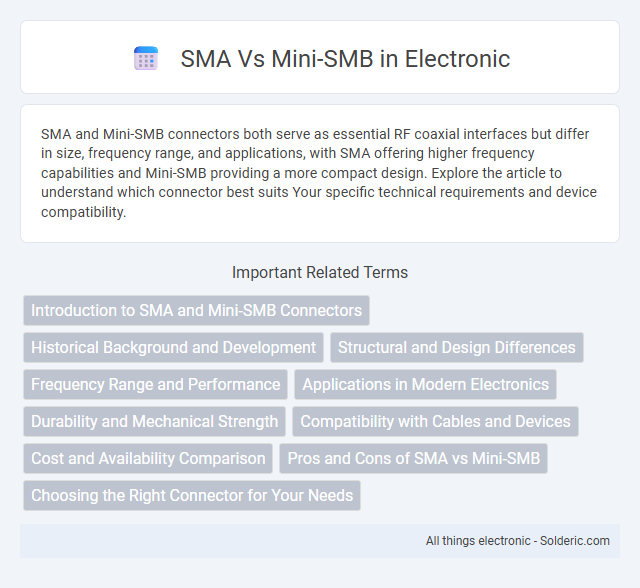SMA and Mini-SMB connectors both serve as essential RF coaxial interfaces but differ in size, frequency range, and applications, with SMA offering higher frequency capabilities and Mini-SMB providing a more compact design. Explore the article to understand which connector best suits Your specific technical requirements and device compatibility.
Comparison Table
| Feature | SMA Connector | Mini-SMB Connector |
|---|---|---|
| Size | 8mm Diameter, Compact | 4.5mm Diameter, Smaller |
| Frequency Range | Up to 18 GHz (some versions 26.5 GHz) | Up to 4 GHz |
| Impedance | 50 Ohms | 50 Ohms |
| Coupling Type | Threaded Coupling | Snap-On Coupling |
| Durability | 500+ Mating Cycles | Approximately 100 Mating Cycles |
| Typical Use | RF, Microwave Systems, Test Equipment | Compact RF Applications, Portable Devices |
| Insertion Loss | Low | Moderate |
Introduction to SMA and Mini-SMB Connectors
SMA connectors are precision RF connectors widely used for microwave frequencies up to 18 GHz, featuring a threaded coupling mechanism for secure connections in high-frequency applications. Mini-SMB connectors, smaller than standard SMB connectors, provide RF connections typically up to 4 GHz with snap-on coupling, offering compactness and convenience in limited space environments. Both SMA and Mini-SMB connectors are essential for reliable signal transmission in communications, instrumentation, and aerospace industries, each optimized for different frequency and mechanical requirements.
Historical Background and Development
SMA (Supplementary Motor Area) and Mini-SMB (Small and Medium-sized Business) represent distinct domains with unique historical development paths. SMA originated within neuroscience as a brain region critical for motor control, with its study expanding since the early 20th century through electrophysiological and imaging techniques. Mini-SMB refers to the classification of enterprises, evolving from post-industrial economic policies emphasizing entrepreneurship and support structures aimed at boosting local economies and innovation.
Structural and Design Differences
SMA connectors feature a threaded interface with a 50-ohm impedance, primarily designed for microwave frequencies up to 18 GHz, offering reliable performance in compact form factors. Mini-SMB connectors, also known as sub-miniature SMB connectors, utilize a snap-on coupling mechanism and support frequencies up to 4 GHz with a 50-ohm impedance, optimized for quick connect and disconnect applications. Structurally, SMA connectors are more robust with a screw-type coupling ensuring a secure and vibration-resistant connection, whereas Mini-SMB connectors prioritize ease of use with their smaller size and push-on interface suitable for limited space installations.
Frequency Range and Performance
Mini-SMB connectors operate effectively within a frequency range up to 4 GHz, making them suitable for applications requiring moderate bandwidth and signal integrity. SMA connectors support higher frequencies, extending up to 18 GHz or more, ensuring superior performance in high-frequency RF and microwave systems. The enhanced frequency capability of SMA connectors provides better insertion loss and return loss characteristics, which are critical for advanced communication and instrumentation equipment.
Applications in Modern Electronics
SMA connectors are widely used in high-frequency applications such as RF and microwave systems due to their superior performance up to 18 GHz, making them ideal for cellular base stations and antenna connections. Mini-SMB connectors, though smaller and compact, excel in applications requiring space-saving solutions with reliable snap-on coupling, commonly found in GPS devices and portable communication equipment. The choice between SMA and Mini-SMB depends on frequency requirements and form factor constraints in modern electronics design.
Durability and Mechanical Strength
SMA connectors offer superior durability and mechanical strength due to their threaded coupling mechanism, ensuring secure connections resistant to vibration and environmental stress. Mini-SMB connectors, while compact and suitable for space-constrained applications, typically provide less mechanical robustness and are more prone to damage under mechanical strain. Your choice should prioritize SMA connectors when reliability and long-term durability are critical in harsh operating conditions.
Compatibility with Cables and Devices
SMA connectors provide high reliability at microwave frequencies and are compatible with coaxial cables like RG-58 and RG-142, supporting a wide range of RF devices including antennas and test equipment. Mini-SMB connectors, designed for compact spaces, work with smaller coaxial cables such as RG-316 and are commonly used in telecommunications and mobile devices. Compatibility between SMA and Mini-SMB connectors requires adapters due to differences in size and coupling mechanisms, ensuring proper signal transfer and device integration.
Cost and Availability Comparison
SMA connectors generally offer higher availability due to widespread adoption in RF and microwave applications, while Mini-SMB connectors are less common but provide similar performance in compact designs. Cost-wise, Mini-SMB connectors tend to be more affordable for small-scale or budget-conscious projects, whereas SMA connectors, due to their robustness and standardization, may incur higher prices. Your choice between SMA and Mini-SMB should consider both the availability in your supply chain and the specific budget constraints of your project.
Pros and Cons of SMA vs Mini-SMB
SMA connectors offer superior performance at higher frequencies up to 18 GHz, making them ideal for precision RF applications, but they tend to be bulkier and more expensive compared to Mini-SMB connectors. Mini-SMB connectors provide a compact design suitable for space-limited environments and offer quick connect/disconnect features, though their frequency range is typically limited to 4 GHz and they may have slightly higher insertion loss. Choosing between SMA and Mini-SMB depends on the specific requirements for frequency, size constraints, durability, and cost efficiency in the intended application.
Choosing the Right Connector for Your Needs
Selecting the right connector between SMA and Mini-SMB depends on application requirements such as size, frequency range, and durability. SMA connectors offer excellent performance up to 18 GHz with superior mechanical stability, ideal for high-frequency RF applications. Mini-SMB connectors provide a compact design suitable for space-constrained environments but typically support lower frequency ranges around 4 GHz, making them optimal for moderate performance demands.
SMA vs Mini-SMB Infographic

 solderic.com
solderic.com